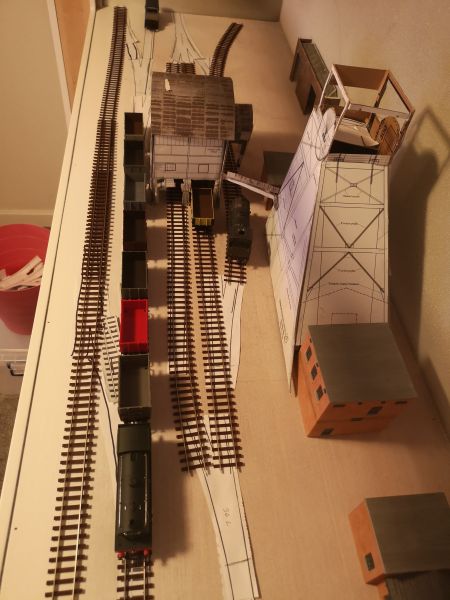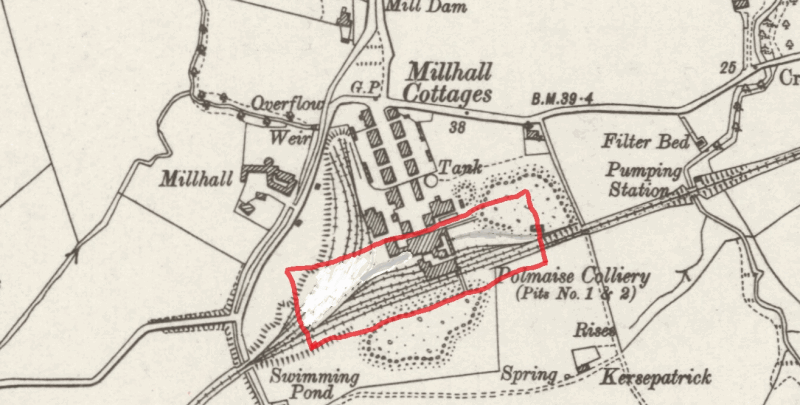Cameo coal mine design
Posted
#242166
(In Topic #13392)
Full Member
00 gauge track layout - comments?
I'm playing about with track plans for my current project capturing a small Scottish coal mine form the 1950-60'sI'm limited in space 145cm x 45cm with a 90cm fiddle yard on left of the layout
All points will be handbuilt code75BH & SMP flexi track, probably will be A4's due to space constraints. As an industrial railway I'm happy with that.
I've attached a plan I made. The line top left is intended to be a mineral railway to the other shafts some distance away. This will be linked to the fiddle yard allowing shunting and change of stock etc. This runs (via a not very prototypical 3 way, i know) into 3 lines under the screens.
Having played with various track layouts, I did want something that I wouldnt get bored operating after 5 mins , so I managed to shoehorn in a further 2 lines in front of the mine to represent a main line transfer sidings
The nearest line would again connect to the fiddle area allowing the empties to arrive via a mainline loco and depart.
Operating I see coal wagons arrive on track1 moving up to track 2 sidings (they hold 6-7 wagons). Reverse to leave guardsvan. Mainline loco uncouples and NCB loco comes down to pick up coal empties, using the mineral line to fiddle to shunt - backing under screens. Locos wouldnt fit under main 2 screens but could get round the top (track5 ) line. Top left could be a small loco shed
I would appreciate any positive comments on operation & whether I could improve in this space. At first the layout felt to me cramped but then thats what a lot of the mines were like
At the moment I have only got DC and hadnt really thought about DCC . I'll most likely keep the points analogue but cetainly Im wondering about DCC especailly as it would allow me sound. What do you think?


Posted
Full Member
That looks an awful lot of track in a small space but by the time you get all that coal dust and filth spread about I am sure that it will look wonderful - you will certainly not get bored after 5 minutes with incoming empties, loading and departing cuts of wagons. I'm no expert but you could probably run various eras as well - I don't suppose mines changed that much over 50 years. I am sure there will be a lot of people on here following your progress with interest.
Barry
Shed dweller, Softie Southerner and Meglomaniac
Posted
Full Member
here's my original idea without the "main line" link. Come to think of it. I probably prefer this design

Posted
Full Member
Cheers
Andy
Andy
Posted
Inactive Member
Kinneil pits Georeferenced Maps - Map images - National Library of Scotland
Now you wouldn't believe that had been there, it's landscaped and forrested… Google Maps'ness/@56.0124555,-3.6353308,1400m/data=!3m1!1e3!4m5!3m4!1s0x4887d652b0fb7533:0xda531a858ce9ddd4!8m2!3d56.0130357!4d-3.6035314
Now I've finally started a model railway…I've inherited another…
Posted
Full Member
Welcome.
One of those times when an Ordnance Survey map from the '40's or '50's comes in useful when doing track designs. Even small mines produced a lot of coal - 4.5 tons per shift per miner was common, so even 50 miners on a one shift working would be producing around 20 wagon loads a day. Which meant around 60 wagons in the sidings (20 empty, 20 being loaded, 20 full).
How about an approach where one side is being modeled - into the screens for example - and using the fiddle yard for the other half and shunting? That would give you longer track runs. No main line, that is at the other end of the fiddle yard. You should also have some means of moving spoil. And a run around from the fiddle yard to the beginning of the sidings so that empties can be added to the wagons going through the screens.
Nigel
©Nigel C. Phillips
Posted
Full Member
One of those times when an Ordnance Survey map from the '40's or '50's comes in useful when doing track designs. Even small mines produced a lot of coal - 4.5 tons per shift per miner was common, so even 50 miners on a one shift working would be producing around 20 wagon loads a day. Which meant around 60 wagons in the sidings (20 empty, 20 being loaded, 20 full)
Taking on board comments I've looked at the plan again.How about an approach where one side is being modeled - into the screens for example - and using the fiddle yard for the other half and shunting?
My issue has always been the dilemna between modelling a decent reproduction of a local colliery - well as much as would fit in the space- as a static diorama or having a much compromised layout where I could use it to actually run trains.
I've extensively looked at local maps and have a good knowledge of local mines/collieries. It had screens and a Baum washer which is what I want to model. I'm only going to model one of the shafts (headgear) the other will be assumed to be in backgorund - painted on.
I've based my model on a medium sized colliery such as Bannockburn No 3 pit. In 1948 went from 100 tons a day to 400 - about 30 wagons load
Here's my ammended track plan and map/photo of Bannockburn as well as a couple of other local collieries so hopefully you can see where I'm trying to come from
Dave




1 guest and 0 members have just viewed this.

